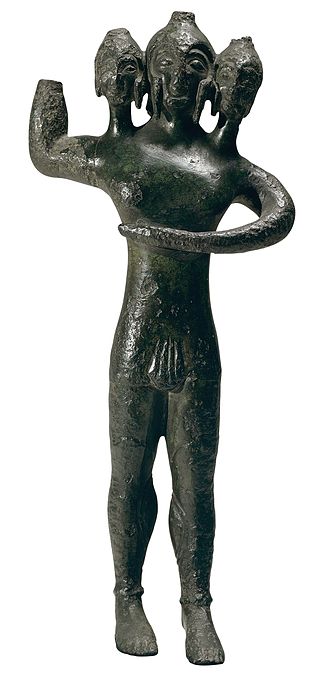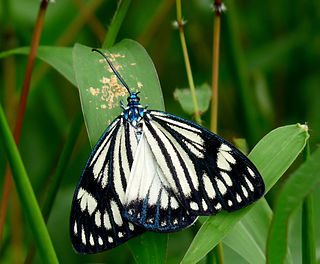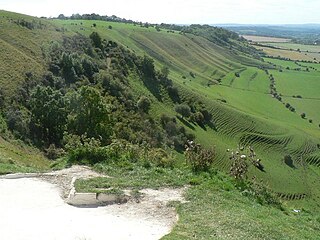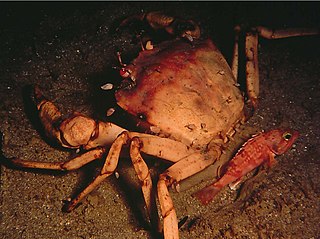
In Greek mythology, Geryon, son of Chrysaor and Callirrhoe, the grandson of Medusa and the nephew of Pegasus, was a fearsome giant who dwelt on the island Erytheia of the mythic Hesperides in the far west of the Mediterranean. A more literal-minded later generation of Greeks associated the region with Tartessos in southern Iberia. Geryon was often described as a monster with either three bodies and three heads, or three heads and one body, or three bodies and one head. He is commonly accepted as being mostly humanoid, with some distinguishing features and in mythology, famed for his cattle.

In Greek mythology, Orthrus or Orthus was, according to the mythographer Apollodorus, a two-headed dog who guarded Geryon's cattle and was killed by Heracles. He was the offspring of the monsters Echidna and Typhon, and the brother of Cerberus, who was also a multi-headed guard dog.

The Zygaenidae moths are a family of Lepidoptera. The majority of zygaenids are tropical, but they are nevertheless quite well represented in temperate regions. Some of the 1000 or so species are commonly known as burnet or forester moths, often qualified by the number of spots, although other families also have 'foresters'. They are also sometimes called smoky moths.

Autobiography of Red is a verse novel by Anne Carson, published in 1998 and based loosely on the myth of Geryon and the Tenth Labor of Herakles, especially on surviving fragments of the lyric poet Stesichorus' poem Geryoneis.

The family Phylliidae contains the extant true leaf insects or walking leaves, which include some of the most remarkably camouflaged leaf mimics (mimesis) in the entire animal kingdom. They occur from South Asia through Southeast Asia to Australia. Earlier sources treat Phylliidae as a much larger taxon, containing genera in what are presently considered to be several different families.

Bratton Downs is a 395.8 hectare biological and geological Site of Special Scientific Interest in Wiltshire, England, near the villages of Bratton and Edington, and about 3 miles (5 km) east of the town of Westbury. It was notified in 1971. The designated area consists mainly of chalk grassland, as well as some ancient woodland, and supports a diverse range of native flora and fauna. It overlays notable geological features—principally landforms created by glaciation in the Pleistocene.

Mount Geryon is a mountain in the Central Highlands region of the Australian state of Tasmania. The mountain is part of the Du Cane Range and is situated within the Cradle Mountain-Lake St Clair National Park.

Crab fisheries are fisheries which capture or farm crabs. True crabs make up 20% of all crustaceans caught and farmed worldwide, with about 1.4 million tonnes being consumed annually. The horse crab, Portunus trituberculatus, accounts for one quarter of that total. Other important species include flower crabs, snow crabs (Chionoecetes), blue crabs, edible or brown crabs, Dungeness crab, and mud crabs, each of which provides more than 20,000 tonnes annually.

Chaceon fenneri, commonly known as the golden crab or golden deepsea crab, is one of several species of crab harvested for food by humans. It was formerly called Geryon fenneri. Like the blue crab, its common name comes from the color of its shell; it is usually cream to tan in color. Both parts of the binomen Chaceon fenneri commemorate Fenner A. Chace, Jr. It is found on the ocean floor at depths of 200 to 1,500 m (660–4,920 ft) in the tropical west Atlantic, ranging from the Gulf of Mexico to Brazil. It cannot swim. The carapace of this large crab measures up to 20 cm (7.9 in), making the entire animal similar in size to a dinner plate. Its diet includes benthic (bottom-dwelling) organisms like mollusks and worms.

Hippotion geryon is a moth of the family Sphingidae. It is known from Madagascar and the Comoro Islands.

Adscita is a genus of moths of the family Zygaenidae.

Hippotion is a genus of sphinx moths. The genus was erected by Jacob Hübner in 1819.
Sherburn Hill is a Site of Special Scientific Interest in County Durham, England. It lies just south of the road between the villages of Sherburn and Sherburn Hill, some 5.5 km east of Durham city. A disused quarry occupies part of the site.

Adscita geryon, the cistus forester, is a moth of the family Zygaenidae. It is found in southern and central Europe, east to Turkey. It is also present in Great Britain.

Antirrhea is a Neotropical genus of butterflies from the family Nymphalidae.

Geryonidae is a family of crabs, including the following genera and species:

Geryon trispinosus is a species of crab that lives in deep water in the north-eastern Atlantic Ocean.
Pseudomicrophyllium geryon is a species of phasmid or leaf insect. It is found in the Philippines, Java, and Sri Lanka.

Geryon longipes is a species of crabs belonging to the family Geryonidae.

















